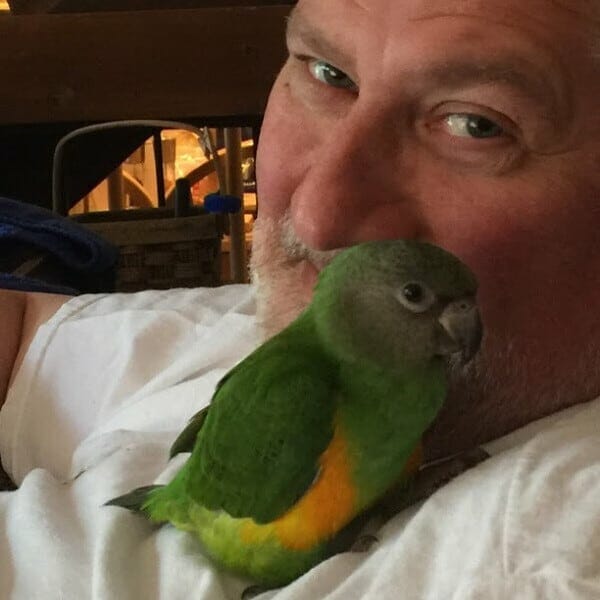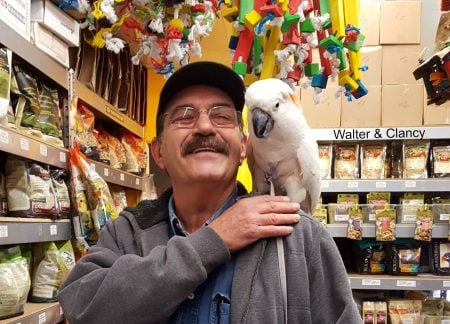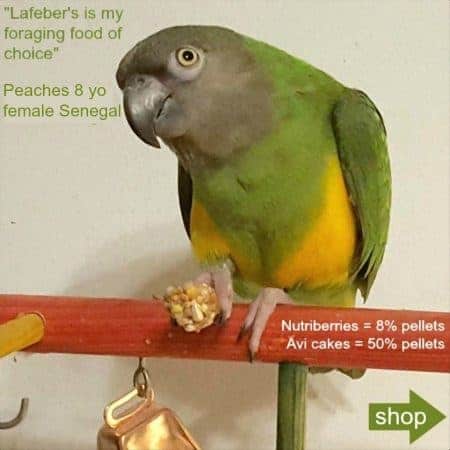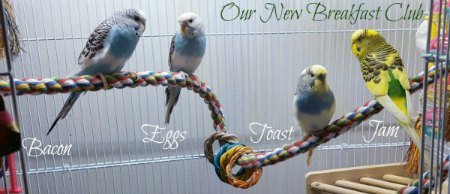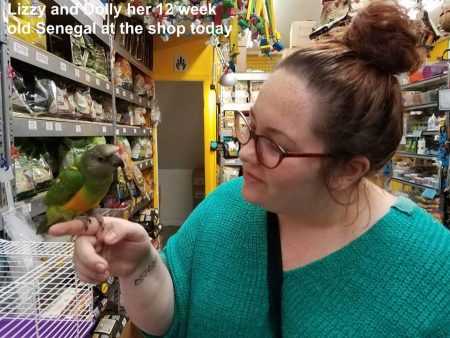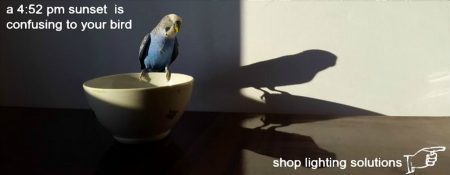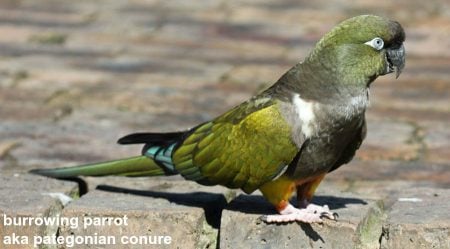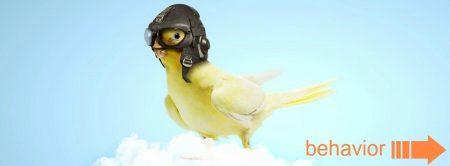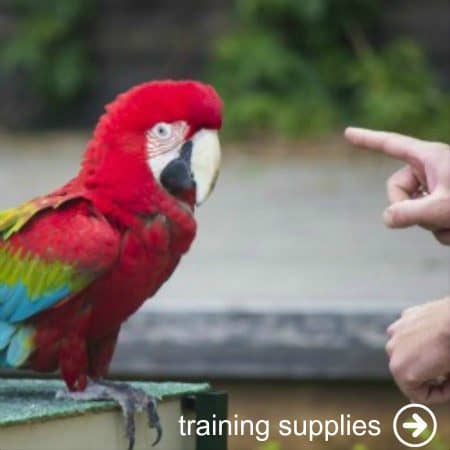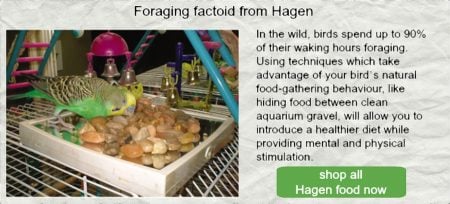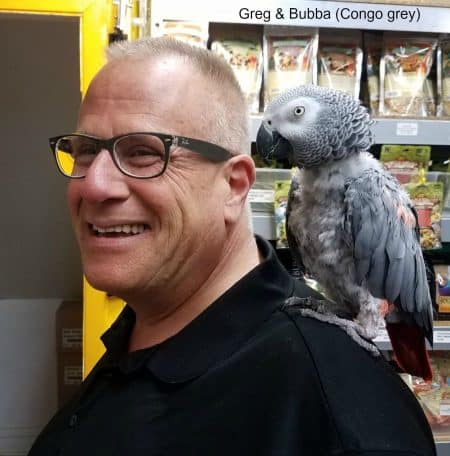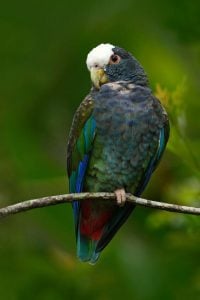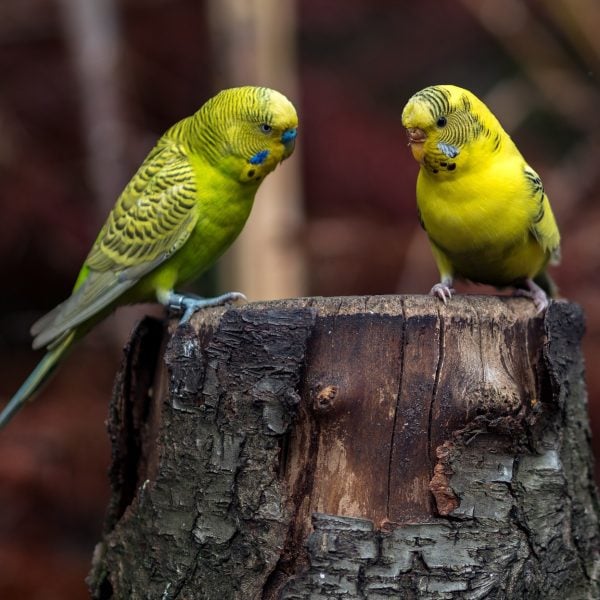Last Updated on by Mitch Rezman
Pet food manufacturers as well as Internet “influencers” somehow associate the word “holistic” with “healthy” which indicates (to me) they clearly never read the definition of “holistic“.
ho·lis·tic – adjective
PHILOSOPHY – characterized by comprehension of the parts of something as intimately interconnected and explicable only by reference to the whole.
Thus from this point forward, you will go forth and snigger the next time someone tries to sell you holistic anything.
When you interact with us,
whether it be here, on our website, social media, email, or any other form of communication, we try to introduce you to holistic bird health as a way of succeeding with captive bird care – meaning:
- Nutrition
- Cage environment
- Lighting/light cycles
- Out of the cage environment
- Whether clipped or flighted
- Training
- Sexuality
- Species
- Foraging & enrichment opportunities
- Exercise
- Frequency of bathing
- Other feathered flock members
- Human flock members
Here’s what we mean
Your bird(s).
When we talk about the challenges caged bird keepers face, be it the wrong perceptions about a bird’s fear of change, screaming, feather self destruction, and yes arthritic feet (it’s a thing), we need to take a 360° view of the animal.
I said it. Your pet bird is an animal. An animal that can process thought 3 times quicker than any mammal and can fly – a very special animal.
Today it seems humans can’t leave their home without a backpack filled with 12 pounds of beverages, electronics and snack food, whilst wearing microfiber clothing and $100 sneakers (in the winter – really?).
A wild 100 or 200-gram bird can survive decades with nothing more than its feathers, beak, and zygodactyl feet. Do we really know what’s best for our birds or do we want them to conform to our ideas of what’s best (he asks rhetorically)?
It’s not easy to care for caged birds. You can find supplies on this website to provide care for more than 700 species of exotic birds out of the 10,400 known bird species on the planet. For the record, there is only one species of dog (Google it).
A Chihuahua, German Shepherd, Beagle, and a mini Doberman can all can play with a single tennis ball or sock tied in a knot.
A Scarlet macaw bird toy, would crush a budgie if dropped upon one. Lovebirds and parrotlet’s although similar in size do share the same category of bird toy sizes but when placing them in the cage it’s good to know that lovebirds may like to hang from the cage wall while engaging with their toys while parrotlets prefer a more conventional approach of hanging toys around the perimeter of the birdcage ceiling.
Humans will hang bird toys from the cage roof’s center. Then exclaim “my bird doesn’t play with that new toy I blew 20 bucks on”.
Can your bird reach the toy? Is there a gateway perch or 2 providing access to the toy or does the bird have to uncomfortably stretch too far for access?
What if the bird gets stuck between the toy and birdcage wall?
Do you know your bird’s inside cage navigation paths? Are perches structured so no poop falls from above?
Pro tip: If a perch gets a concentrated area of poop from above, wrap the perch with vet wrap and replace as needed.
Let’s get granular with our categories of captive bird care. Getting nutrition right is the single hardest but most important place to start.
Nutrition
It’s hard to find precise statistics but if you talk to enough avian veterinarians you’ll learn that almost 50% of pet bird deaths are caused by malnutrition.
Feeding the single species of dog is a snap. Dogs will happily eat mostly kibble (aka pellet if you’re feeding “engineered food” to birds).
A Congo African grey can crack open a walnut, a cockatiel cannot thus we offer 26 brands of bird food ensuring the nutritional needs of all the bird and parrot species in our niche.
If you’re not sure even what to look for or just seeking suggestions on bird food, recommendations – please click here to reach out.
Cage(s) environment(s)
We have no rules for proper cage size. Over time if you have one or more birds you’ll end up with multiple cages for transport and/or sleeping.
Beyond allowing a bird to stretch its wings horizontally, we feel the shape size and style of its primary cage is determined by the bird, the room its in and the family’s lifestyle.
Today many freelancers and telecommuters working from their home office are also captive bird keepers. This enables their bird(s) to be out of the cage most daylight hours. The cage then serves mainly as a sleeping cage.
In this case, you can get away with a smaller (day) birdcage. If a bird is held captive in a cage 12 hours a day because of the owner’s family’s “life”, a larger birdcage is in order.
Many people get hung up on the specifics of birdcage bar spacing not realizing that some manufacturers measure from between the two bars, others manufacturers measure from outside the two bars and some manufacturers measure from the center of both bars.
Which means we make it a priority to look at other areas of the cage that a bird can possibly escape from like around bird food and water dish doors.
The top third of your cage should hold a minimum of 10 upwards to however many bird toys work for your bird and the cage.
We don’t think there can ever be enough bird toys in a bird’s cage. Different shapes textures and goals.
Mechanical toys have the goal of getting one or more treats by performing certain (cerebellar) tasks. The goal of shredding toys is to destroy the toy. Other toys (having calcium parts per se – per se? does anyone really still use that?) help with beak trimming duties.
We’ll sell you bird toys AND show you how to make your own bird toys on the cheap.
The canopy effect is when bird toys are not only a form of education, foraging and enrichment but they represent the leaves of the trees your bird would be living in the wild providing privacy.
Birds are prey animals. In their natural environment, they spend 60% of their time searching for food and 40% of the time trying not to be food.
Birds like the privacy of a birdcage full of toys much like you have window coverings in your home.
Ideally bird cages should be placed against two walls in a corner of a room to allowing the bird to feel less exposed which helps make the bird feel secure.
The problem with putting bird cages in front of big picture windows is that birds do not understand the meaning of glass and can be spooked by feral cats or hawks flying by not comprehending the protection the clear glass window affords them which can lead to stress.
We remove the grates from our cages and just lay down the newspaper. We have a Senegal parrot and 4 budgies all rescues. Yep – we walk the walk.
Lighting/light cycles
Light affects birds on much deeper levels than mammals. Sunlight passing through a bird’s eye passes to the pineal gland which in conjunction with things like melatonin, enables vibrating cells that keep time like a musician’s metronome.
Birds know what time it is as accurate as a Rolex but they just don’t know what day it is.
Light cycles control a bird needs to breed, molt or migrate. The problem is that we keep our birds in North America with light cycles that change throughout the year, confusing our birds and disrupting their circadian rhythms.
Most parrots and parakeets are natively found in equatorial regions of earth which have approximately 12 hours of light and 12 hours of darkness and that’s been for the past 99 million years or so.
To be clear I loosely define equatorial regions to be between the Tropic of Cancer and the Tropic of Capricorn each lie at 23.5 degrees latitude.
The Tropic of Cancer is located at 23.5° North of the equator and runs through Mexico, the Bahamas, Egypt, Saudi Arabia, India, and southern China.
The Tropic of Capricorn lies at 23.5° South of the equator and runs through Australia, Chile, southern Brazil (Brazil is the only country that passes through both the equator and a tropic), and northern South Africa. [More about latitude and longitude here]
……………which is where most parrots hark from.
Do you know what your bird’s instinctual expectations are?
Newsflash – they don’t necessarily align with yours or the internet or “what you’ve heard”.
For 99 million years, parrots have been feeding themselves, making babies, finding homes in logs, under rocks and in the ground (burrowing parrot aka Patagonian conure) without the help of a single human.
Yet ever since the Alexandrine parakeet got named after Al T Great in the mid-third century BC we’ve been keeping birds captive.
Feathered factoid. Quaker parrots aka monk parakeets are the only parrots to build nests.
Here we are 24 centuries later. Bird rescues are overflowing because humans learned expectations don’t align with their bird’s instinctual expectations.
Negative behaviors like screaming, plucking, prolific egg laying and other hormonal problems discourage even the most well-intentioned pet bird companion.
One of the easiest ways to help prevent the aforementioned unfavorable behaviors and help your bird make more sense of life by keeping its circadian clock in tune can be done simply with artificial light connected to a timer placed directly over the birdcage.
By setting the timer for 12 hours on and 12 hours off (not respecting daylight savings time) your bird will know when the day begins and when it ends in a time more closely related to its equatorial instinctive expectations see as discussed above.
Out of the cage environment
What is your plan when you remove the bird from the cage? Where do you put the bird?
We know that all birds need to chew and most parrots poop about every 15 minutes. Do you have the apparatus to handle those two main criteria, i.e. a bird play stand and/or a play top birdcage.
Your bird doesn’t know the difference between a $100 tabletop bird stand and your $250 kitchen chair.
Because your bird doesn’t have access to the Internet it doesn’t know the proper perch size or diameter. It’s best to have at least three types of perches, hardwood, softwood, and a soft rope perch for sleeping on.
Grooming perches are okay but they should be kept near low traffic areas like food dishes. Where they are active for five or 10 minutes and then get off the grooming perch so it is not too abrasive on their feet
We are advocates for keeping birds flighted. A flighted bird is a happier healthier bird. A flighted bird gets exercise and is less hormonal because of the energy burn.
A flighted bird can more easily balance on perches especially at night in the dark, meaning there is less likelihood of them falling.
Keeping all the flight feathers on a bird can avoid feather plucking as birds tend to over preen the rough edges on flight feathers left by even the smoothest of surgical scissors.
If other animals are in the house, flight allows the bird to escape.
In that birds are prey animals they have a flight or bite mentality. They can’t fly away when they sense danger They can and will, lash out and bite because they can’t fly away fleeing the danger.
Wing clipping reduces the chances of humans being bit by birds – which is never acceptable.
If you elect to clip your birds wings, we will work with you to understand how to properly trim flight feathers so as to keep your bird safe.
Remember, even with clipped wings your bird can fly across the state in a heartbeat with the right wind, out of doors.
Feathers
Small parrots have 2000 to 5000 feathers. Larger parrots can have 7000 or 8000 feathers. Depending upon the species all of these feathers are replaced every year or over a number of years.
Feathers are everything to a bird. It keeps them warm in the cold. They keep water from touching its skin. Feathers enable flight.
Also known as an integumentary system (skin, fur, scales depending upon the species are all integumentary systems) takes quite a lot of work keeping all the feathers properly oiled (oil from its preening gland applied by its beak) and zippered.
Feathered factoid: Amazon parrots have no preening gland thus must be bathed more than other parrots.
Training
Five minutes of clicker training five days a week will change your relationship with your bird. If you have a screamer or a biter that’s hard to handle, start with clicker training. You will be amazed at its effectiveness.
Sex
We have had these birds for years and assume that they are of a certain sex because we were told that at some point with no verification.
It is opaque to me why a pet bird companion will not spend $20 and get its bird DNA sexed? A bird that is not laying eggs proves nothing. Eggs can slip out the fallopian tube and get caught in folds of fat.
Lack of egg production does only implies male but proves nothing.
Knowing if a bird is a female is especially helpful when a bird molts. Molting challenges all the bird’s systems but primarily the digestive system gets severely taxed as the system converts proteins into amino acids necessary to replace those thousands of feathers.
If a bird should come into a brooding mode during the molt there is even more demand for calories, vitamins and other biologically necessary chemicals and compounds (as much as a 30% bump in caloric demand is made during a brooding period by the body).
Brooding females can have a totally different personality when they are in mommy mode. You may not even recognize your bird during these periods.
Look for it and know how to deal with your bird’s potential different personalities.
Many people say that alpha males are a myth when it comes to pets. Try convincing someone who’s had to “pry” a moody Green wing macaw off the top of a 7-foota tall parrot cage.
As mentioned before we provide care solutions for an enormous number of bird species. Not all pet birds are created equal. They may be similar within a given flock species, but bird species traits can be remarkably different.
As an example, we rescued our Senegal, Peaches. She had spent literally seven years in a cage 22 hours a day and her only caregiver was a woman. We naturally assumed Peaches would bond with Catherine.
We knew Senegal’s were basically a one-person bird but surprisingly the only human that she will positively interact with is me – a man. She will demonstrate outright defiance with anyone else including Catherine.
Now take the African grey parrot (both Congos and timnehs). An African grey will bond from a young fledgling until it’s four or five with a single person.
And then it may re-bond with another person in the family at the age of 5 or 6 if available. In the wild, this keeps the species clean by reducing inbreeding.
Remember birds are flock animals and you are their flock
Foraging and enrichment opportunities
When asked what is the appropriate cage size for a large macaw I usually recommend no less than 30 square miles.
An adult macaw in the wild will fly anywhere from 20 up to 100 miles in a given day. Stopping dozens of times in known places for food and water.
Sometimes the food is not so apparent and the birds have to dig for it in dead or rotten trees, under rocks, and on the ground. This is called foraging. Birds are hardwired to look for food that’s what they do.
We get surprised when they throw food from their overfilled food bowl and ignore the $10 a pound stuff – which looks just like the $3 a pound stuff.
Your bird doesn’t really want to eat just from an endless bowl, it wants to work for food which is what we call foraging and enrichment.
At least cover the bowl with paper. Drop toys and toy parts over the bird food so the bird has to pull out stuff before it accesses the food.
We have foraging boxes around our apartment with the bottom of the boxes filled with treats like almonds, Nutriberries, and mixed nuts. Peaches has become very efficient at uncovering the food.
We’re now using more, small bird toy parts enabling us to pack the foraging box tighter continually providing more of a challenge.
When we put Peaches down somewhere in the apartment, she’s always in an area where she can access something as simple as a pile of business cards covering some nuts. This keeps her happy and occupied for 10 or 20 minutes.
A Better Bird Ep 7
Harry’s Razors Box Repurposed Into Foraging Bird Toy ~ Video
Please do not deprive your bird of these enrichment activities including toys of various materials and outcomes (mechanical toys that offer a single treat after manipulating the toy for several minutes)
Exercise
Your bird has a standing heart rate of 200 bpm that doubles the instant it achieves flight.
Humans can’t imagine that efficiency but also like humans birds can develop fat around their heart and around their liver and other parts of the body unless they exercise.
Flying is one of the best exercises. Should you elect to keep your birds wings clipped you can hold their feet and allow them to flap their wings.
Make them run circles around a small blanket like a toddler or walk up and down the stairway.
Keep your birdcage challenging giving them several pathways to get from one place to another. Place treats at various levels of the cage to encourage cage bar climbing which helps keep their feet in shape.
In the South American rainforest birds get a gentle misting seven days a week which helps them keep their feathers clean and organized.
Even in the driest of deserts in Australia or the Serengeti plains in Africa, birds know where safe waterholes can be found sometimes by scouting themselves and other times led by different species.
All birds need to get their feathers wet in order to keep them in the proper arrangement and healthy-looking.
Other feathered flock members
If you have a solitary bird that you may think is lonely and not as sociable as you would like to be, get a second bird and earn the elevation from bird companion to zookeeper.
In many cases, the two birds will bond and give new meaning to two’s company and three’s is a crowd.
Birds are much like potato chips, sometimes you can’t have just one. Those bird keepers that have multiple birds and multiple species have their work cut out for them.
Introducing birds to new birds has to be done under the closest of supervision with two or more birds never being left alone for several weeks or even a couple months until their relationship is established.
We have four budgies, one male and three females. We duplicate everything in their cage. 2 food dishes or a large bird food dish.
Two water dishes, a community millet holder where everybody has room to work, and different combinations of toys in all four corners of the cage.
This duplication overcomes jealousies that might pop up say where one bird blocks access to another bird’s water, thus 2 water dishes keep everyone happy, as an example.
Human flock members
Birds react to different family members in different ways. It may do with the species (human and avian).
Eclectus parrots are great family birds. As we found out, Senegal parrot’s may not be a family bird
When searching for a new pet bird talk to all the right people, us, rescues, and veterinarians.
If you are going to buy a bird from a breeder get the background of the breeder. The best place to start is with the breeder’s vet.
Yeah – we know birds – how can we help?
We took them out of the sky. It’s our responsibility to provide the best care possible and keep suffering to a minimum.
Written by Mitch Rezman
Approved by Catherine Tobsing
your zygodactyl footnote
Author Profile
Latest entries
 Bird BehaviorJune 13, 2025Why Do Some Parrots Struggle in Captivity?
Bird BehaviorJune 13, 2025Why Do Some Parrots Struggle in Captivity?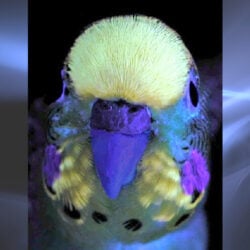 Bird & Parrot AnatomyJune 12, 2025Why are Budgerigars Called The Colorful Parrots?
Bird & Parrot AnatomyJune 12, 2025Why are Budgerigars Called The Colorful Parrots?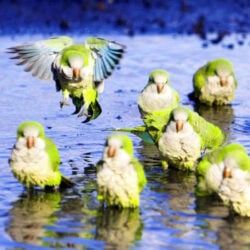 Bird & Parrot AnatomyJune 12, 2025How Do Monk Parakeets Talk to Each Other?
Bird & Parrot AnatomyJune 12, 2025How Do Monk Parakeets Talk to Each Other?  Bird BehaviorJune 10, 2025How Cockatoos Learned to Use Drinking Fountains Like People
Bird BehaviorJune 10, 2025How Cockatoos Learned to Use Drinking Fountains Like People
